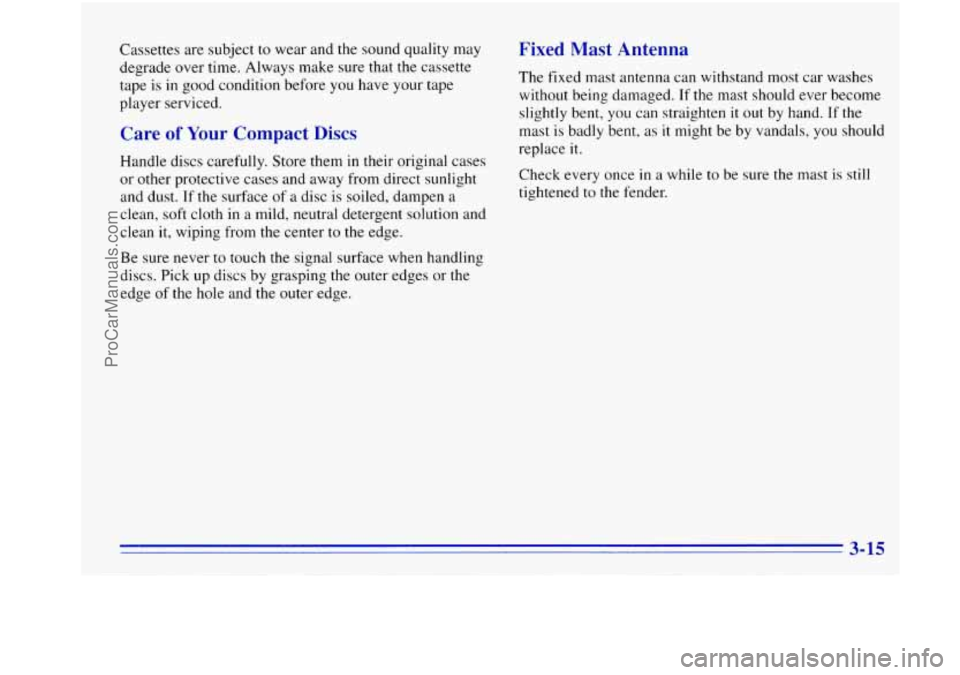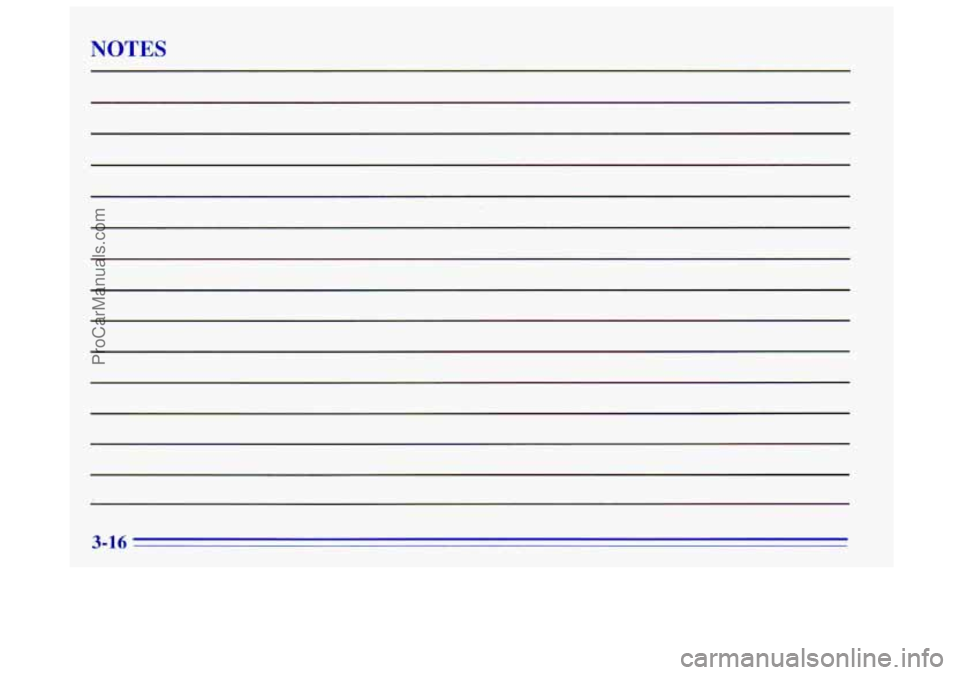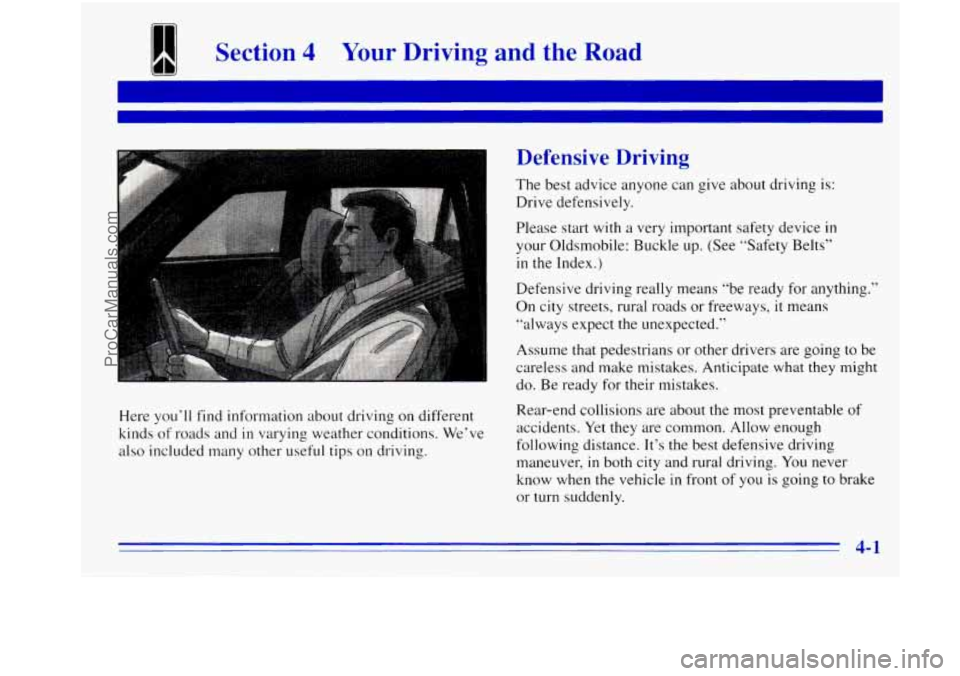OLDSMOBILE BRAVADA 1996 Owners Manual
Manufacturer: OLDSMOBILE, Model Year: 1996, Model line: BRAVADA, Model: OLDSMOBILE BRAVADA 1996Pages: 340, PDF Size: 17.49 MB
Page 121 of 340

AM-FM Stereo with Compact Disc Player
(Option)
Playing the Radio
POWER-VOL:
This knob turns the system on and off
and controls the volume when
the ignition is on. Volume
is displayed unless BAL, FADE,
BASS or TREB
are adjusted.
MUTE: Press this button to stop all sound from the
radio or compact disc player. Press MUTE again to
resume sound.
RCL: Press this button to display the time with the
ignition off and to switch between
the clock and radio
when
the radio is on.
3-9
Finding a Station
TUNE-BAND:
Turn this knob to tune in radio stations.
Press
it to switch between AM and FM. AM or FM will
show briefly on the display.
SEEK: Press the right arrow to go to the next higher
station and the left arrow to
go to the next lower station.
SCAN: Press this button to listen to each station for a
few seconds. SC will appear on the display. The radio
will go
to the next station, stop for a few seconds, then
go to the next station. Press
SCAN again to stop
scanning and stay at
a station.
PUSHBUTTONS: The five numbered pushbuttons
let you return to your favorite stations. They are also
used when you play
a compact disc. You can set up to
10 stations (five AM and five FM).
1. Tune in the desired station.
2. Press SET. (SET appears on the display.)
3. Press one of the five pushbuttons, within five seconds,
to store the station. Whenever you press that numbered
button, the station
you set will return.
4. Repeat the steps for each pushbutton.
ProCarManuals.com
Page 122 of 340

Setting the Tone
BASS:
Press the BASS up arrow to increase bass and
the
BASS down arrow to decrease bass. Press the center
of the button
for the factory-preset bass position. The
bass level will be displayed for about 10 seconds
whenever this button
is pressed.
TREB: Press the TREB up arrow to increase treble and
the TREB down arrow to decrease treble. Press the
center of the button for the factory-preset treble
position. The treble
level will be displayed for about
10 seconds whenever this button is pressed.
Adjusting the Speakers
BAL: This control ring behind the POWER-VOL knob
adjusts the balance between the left and right speakers.
Balance will be displayed briefly when using this control.
FADE: This control ring behind the TUNE knob adjusts
the balance between the front and rear speakers. Fade
levels will be briefly displayed.
Playing a Compact Disc
Insert a disc partway into the slot, label side up. The
radio will pull the disc
the rest of the way in. Wait a few
seconds and the disc should play. If
the disc comes back out and/or
ERR appears on
the display:
0 You are driving on a very rough road. (The disc
should play when the road gets smoother.)
0 The disc is upside down.
It is dirty, scratched or wet.
It is very humid. (If so, wait about an hour and
try again
.)
The disc player is too hot to play the disc. (As soon
as things get back to normal, the disc should play.)
Turn the
POWER-VOL knob to turn the system on.
RCL: Press this button to see what track is playing.
Press it again within five seconds
to see how long it has
been playing. The track number also appears when you
change the volume or when a new track starts to play.
COMP (2): Press this button to make loud and soft
passages more nearly equal in volume.
COMP will
appear on the display while using this control.
RDM (3): Press this button to play tracks in a random,
rather than sequential, order.
RDM will appear on the
display while using this control. Press the button again
to return to normal sequence.
3-10
ProCarManuals.com
Page 123 of 340

REV (4): Press and hold this button to quickly reverse
within
a track (song). Release it to play the passage. The
counter reading will appear on the display while using
this control.
FWD (5): Press and hold this button to quickly advance
within a track (song). Release it to resume playing.
Watch the display to stop at a specific passage.
SCAN: Press this button to listen to each selection for
about six seconds. The disc will go to the next selection,
stop for
a few seconds, then go to the next selection.
Press RDM,
SCAN or any other motion button again to
stop scanning.
PREV Hold the backward arrow or press it more than
once to return
the disc to previous tracks.
NEXT: Press the forward arrow to hear the next track
now instead
of waiting until the current track is finished.
If you hold this button or press it more than once, the
disc will advance further.
ST-PL: Press this button to stop the disc and play the
radio. Press
it again to restart the disc at the point where
it stopped. Press
the POWER-VOL knob or turn the ignition key
off to stop the disc player. The disc stays in the player
and will resume playing at
the point where it stopped.
E JCT Press this button to eject the disc and play the
radio. The disc will
start at track one when you reinsert it.
Theft-Deterrent Feature
Delco LOC II@ is a theft-deterrent feature for the
compact disc player.
It can be used or ignored. If ignored,
the system plays normally. If used, your player won’t be
usable
if it is ever stolen, because it won’t turn on.
The instructions below tell you how to enter a secret
code into the system. It
is recommended that you read
through all 11 steps before starting the procedure. If
your vehicle loses battery power for any reason, you
must unlock the system with your secret code before the
radio will turn on.
NOTE: If you allow more than 15 seconds to elapse
between any steps,
the radio automatically reverts to
time and you must start the procedure over at Step 4.
ProCarManuals.com
Page 124 of 340

Locking the Theft System
1. Write down any six-digit number and keep it in a
safe place separate from the vehicle.
2. Turn the ignition to the ACCESSORY or
RUN position.
3. Press POWER to turn the radio off.
4. Press the I and 4 buttons together. Hold them down
until
--- shows on the display. Next you will use the
secret code number which you have written down.
5. Press SET and 000 will appear on the display.
6. Press SCAN to make the first digit appear.
7. Press SEEK right arrow or SEEK left arrow to
make the next two digits agree with your code.
8. Press BAND and 000 will appear on the display
again. Now you are ready to enter the last three
digits of your code.
9. Repeat Steps 6 and 7 for the last three digits of
your code.
10. Press BAND and the display will show REP for about
five seconds and then
000 will appear on the display.
11. Repeat Steps 6 through 10. This time the display will
show
SEC to let you know that your radio is secure.
Unlocking the Theft System After a Power Loss
Enter your secret code as follows; pause no more than
15 seconds between steps:
1.
2.
3.
4.
5.
6.
7.
Turn the ignition on with the radio off.
Press SET and 000
will appear on the display.
Press SCAN to make the first digit appear.
Press SEEK right arrow or SEEK left arrow to make
the next two digits agree with your code.
Press
BAND and 000 will appear on the display
again.
Now you are ready to enter the last three
digits
of your code.
Repeat Steps
3 and 4 for the last three digits of
your code.
Press BAND after you have confirmed that the code
matches the secret code you have written down. The
time will be displayed indicating that the system is
disabled. If the display shows
SEC, the numbers
entered did not match your secret code and the unit
is still secured.
When battery power is disconnected from a secured
radio,
the radio won’t turn on and LOC will appear on
the display.
3-12
ProCarManuals.com
Page 125 of 340

Disabling the Theft System
2.
3.
4.
5.
6.
7.
Press the 1 and 4 buttons together for five seconds
with
the ignition on but the radio off. SEC will
appear on the display
to show that the unit is in the
secure mode.
Press SET and
000 will appear on the display.
Press
SCAN to make the first digit appear.
Press
SEEK right arrow or SEEK left arrow to make
the next two digits agree
with your code. The display
will show the numbers you entered.
Press
BAND and 000 will appear on the display.
Enter
the second three digits of the code. The display
will show the numbers you entered.
Press
BAND. The disabling sequence was correct
was incorrect
if SEC shows on the display.
if ___ shows on the display. The disabling sequence
Understanding Radio Reception
FM Stereo
FM stereo will give you the best sound. But FM signals
will reach only about
10 to 40 miles (1 6 to 65 km). Tall
buildings or hills can interfere with
FM signals, causing
the sound to come and go.
AM
The range for most AM stations is greater than for FM,
especially at night. The longer range, however, can
cause stations to interfere with each other.
AM can pick
up noise from things like storms and power lines. Try
reducing the treble to reduce this noise
if you ever get it.
Tips About Your Audio System
Hearing damage from loud noise is almost undetectable
until
it is too late. Your hearing can adapt to higher
volumes of sound. Sound that seems normal can be loud
and harmful
to your hearing. Take precautions by
adjusting
the volume control on your radio to a safe
sound level before your hearing adapts to it.
ProCarManuals.com
Page 126 of 340

To help avoid hearing loss or damage:
Adjust the volume control to the lowest setting.
Increase volume slowly until you hear comfortably
and clearly.
.
NOTICE:
Before you add any sound equipment to your
vehicle
-- like a tape player, CB radio; mobile
telephone or two-way radio
-- be sure you can add
what you want.
If you can, it’s very important to
do it properly. Added sound equipment may
interfere with the operation
of your vehicle’s
engine, Delco radio or other systems, and even
damage them. Your vehicle’s systems may
interfere with the operation
of sound equipment
that has been added improperly.
So, before adding sound equipment, check with
your retailer and
be sure to check Federal rules
covering mobile radio and telephone units.
Care of Your Cassette Tape Player
A tape player that is not cleaned regularly can cause
reduced sound quality, ruined cassettes or a damaged
mechanism. Cassette tapes should be stored in their
cases away from contaminants, direct sunlight and
extreme heat. If they aren’t, they may not operate
properly
or may cause failure of the tape player.
Your tape player should be cleaned regularly after every
50 hours of use. If you notice a reduction in sound
quality, try a known good cassette
to see if the tape or
the tape player is at fault. If this other cassette has no
improvement in sound quality, clean the tape player.
Cleaning may be done
with a scrubbing action,
non-abrasive cleaning cassette with pads which scrub
the tape head as the hubs of the cleaner cassette turn. It
is normal for the cassette to eject while cleaning. Insert
the cassette at least three times
to ensure thorough
cleaning.
A scrubbing action cleaning cassette is
available through your Oldsmobile retailer.
You may also choose
a non-scrubbing action, wet-type
cleaner which uses a cassette with a fabric belt
to clean
the tape head. This type of cleaning cassette will not
eject. It may not clean as thoroughly as the scrubbing
type cleaner.
I
ProCarManuals.com
Page 127 of 340

Cassettes are subject to wear and the sound quality may
degrade over time. Always make sure that the cassette
tape is in good condition before you have your tape
player serviced.
Care of Your Compact Discs
Handle discs carefully. Store them in their original cases
or other protective cases and away from direct sunlight
and dust. If the surface of a disc is soiled, dampen a
clean, soft cloth in a mild, neutral detergent solution and
clean it, wiping from
the center to the edge.
Be sure never
to touch the signal surface when handling
discs. Pick up discs by grasping the outer edges or the
edge
of the hole and the outer edge.
Fixed Mast Antenna
The fixed mast antenna can withstand most car washes
without being damaged. If the mast should ever become
slightly bent, you can straighten
it out by hand. If the
mast is badly bent, as it might be by vandals, you should
replace
it.
Check every once in a while to be sure the mast is still
tightened to the fender.
3-15
ProCarManuals.com
Page 128 of 340

NOTES
ProCarManuals.com
Page 129 of 340

1 Section 4 Your Driving and the Road
Here you’ll find information about driving on different
kinds
of roads and in varying weather conditions. We’ve
also included many other useful tips on driving.
Defensive Driving
The best advice anyone can give about driving is:
Drive defensively.
Please start with
a very important safety device in
your Oldsmobile: Buckle up. (See “Safety Belts”
in the Index.)
Defensive driving really means “be ready for anything.”
On city streets, rural roads or freeways, it means
“always expect the unexpected.”
Assume that pedestrians or other drivers are going to be
careless and make mistakes. Anticipate what
they might
do. Be ready for their mistakes.
Rear-end collisions are about the most preventable of
accidents. Yet they are common. Allow enough
following distance. It’s
the best defensive driving
maneuver,
in both city and rural driving. You never
know when the vehicle
in front of you is going to brake
or turn suddenly.
4-1
ProCarManuals.com
Page 130 of 340

Drunken Driving
Death and injury associated with drinking and driving is
a national tragedy. It’s
the number one contributor to
the highway death toll, claiming thousands of victims
every year.
Alcohol affects four things that anyone needs to drive
a vehicle:
Judgment
0 Muscular Coordination
Vision
Attentiveness.
Police records show that almost half of all motor
vehicle-related deaths involve alcohol. In most cases,
these deaths are the result
of someone who was drinking
and driving.
In recent years, some 18,000 annual motor
vehicle-related deaths have been associated with the use
of alcohol, with more than
300,000 people injured.
Many adults
-- by some estimates? nearly half the
adult population
-- choose never to drink alcohol, so
they never drive after drinking. For persons under 2 1,
it’s against the law in every U.S. state to drink alcohol.
There are good medical, psychological and
developmental reasons for these laws. The
obvious way to solve
this highway safety problem
is for people never to drink alcohol and then drive. But
what if people do? How much is “too much” if the
driver plans to drive? It’s a lot less than many might
think. Although it depends on each person and situation,
here
is some general information on the problem.
The Blood Alcohol Concentration (BAC)
of someone
who is drinking depends upon four things:
0 The amount of alcohol consumed
0 The drinker’s body weight
0 The amount of food that is consumed before and
during drinking
0 The length of time it has taken the drinker to
consume the alcohol.
According to the American Medical Association, a
180-lb. (82 kg) person who drinks three 12-ounce
(355 ml) bottles of beer in an hour will end up with a
BAC
of about 0.06 percent. The person would reach the
same BAC by drinking three 4-ounce (120 ml) glasses
of wine or three mixed drinks
if each had 1 - 1/2 ounces
(45 ml) of a liquor like whiskey, gin or vodka.
ProCarManuals.com